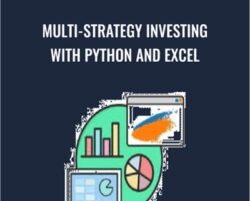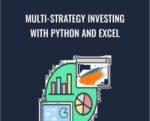What you’ll learnLearn how to install Anaconda and use Jupyter Notebook which is a web-based environment for PythonLearn how to execute Python codes in Jupyter NotebookLearn about variables and data types in PythonLearn the basic data structures used within PythonLearn how to import Python librariesLearn how to extract data from Internet sourcesLearn how to create the opportunity space and efficient frontier for both a multi-asset and a multi-strategy portfolioLearn how to plot and compare the opportunity spaces on the same chart using PythonLearn how to aggregate performance data from the individual strategies onto the multi-strategy model excel fileLearn how to track the performance of the multi-strategy portfolio against its component strategiesLearn how to rebalance across the strategiesLearn how to operate the multi-strategy file and how it interacts with the individual strategy filesRequirementsA basic appreciation of computer language and syntax, but not compulsoryPreferably have completed the Finance Fundamentals for Building an Investment Portfolio courseStrongly recommended to have completed at least two of our Investment Strategy Quantitative Modeling coursesFor the Excel part of the course, we assume that you have already acquired basic financial knowledge and Excel skills taught in our Investment Strategy Quantitative Modeling coursesGet Multi-Strategy Investing with Python and Excel – AllQuant, Only Price $39Do you know that professional money managers have been generating consistent profits every year using a multi-strategy approach?Have you ever wondered why a multi-strategy portfolio is better than a traditional multi-asset portfolio?THIS COURSE WILL CHANGE YOUR PERCEPTION ABOUT THE APPROACH TO INVESTING.We will teach you in-depth on how to create efficient frontiers for both a multi-asset portfolio and a multi-strategy portfolio using Python. We will be using a user-friendly web-based integrated development environment (IDE) called Jupyter Notebook. After we have created the efficient frontiers, we will be able to compare them on the same chart and see that the multi-strategy portfolio is far superior to the multi-asset portfolio.Then you will learn how to pull all the strategies taught in the following quantitative investment strategy modeling courses into a multi-strategy approach using MS Excel:1. All-Weather Investing Via Quantitative Modeling In Excel (Risk Parity)2. Defensive Stock Investing Via Quantitative Modeling In Excel (Trend Following)3. Volatility Trading Via Quantitative Modeling In Excel (Volatility Risk Premium)4. Stock Sector Investing Via Quantitative Modeling In Excel (Sector Rotation)You will see how you can track the performance of the multi-strategy portfolio, how to allocate capital across your strategies, and when to implement rebalancing.Note that the details of the individual strategies are not covered in this course. It is highly recommended that you complete at least 2 of the strategy courses, if not all, as they also cover the elementary knowledge behind key investment concepts, financial mathematics, and basic excel skills.No programming experience is required. Neither do we need expensive tools or data subscriptions. We will use only free resources.WHAT YOU WILL LEARNLearn the basics of Python in a user-friendly web-based IDE called Jupyter Notebook.How to use Python to import price data from Internet sources.How to calculate annualized return and volatility from price data time series.How to create opportunity space and an efficient frontier for both a multi-asset and a multi-strategy portfolio.How to plot and compare opportunity spaces on the same chart.How to aggregate performance data from the individual strategies onto the multi-strategy model excel file.How to track the performance of the multi-strategy portfolio against its component strategies.How to rebalance across the strategies.How to operate the multi-strategy file and how it interacts with the individual strategy files.WHAT YOU WILL GETOver 5 hours of lectures developed with more than 30 years of experience in the asset management, hedge fund, and banking industry.Guided step-by-step model building process complete with templates.Fully completed multi-strategy model file that you can use or improve on.Unlimited lifetime access.Full 30-day money-back guarantee. No questions asked.Online Q&A support to address your learning needs.An investment in the right education is one of the best investments one can make. The earlier you start, the better you will be in the future. So take action now and ENROLL IN THIS COURSE!Who this course is for:Beginner Python developers who are curious about using Python for Quantitative FinanceInvestors who are interested in using Python to create efficient frontiers for their investment portfoliosNote that this course is conducted in Python 3 for Windows usersStudents from our Investment Strategy Courses who wants to implement a multi-strategy approach using MS ExcelCourse contentIntroductionSetting Up Jupyter Notebook IDE for Python 3Python BasicsCreating Efficient Frontier for Multi-Asset PortfolioCreating Efficient Frontier for Multi-Strategy PortfolioComparing Multi-Asset Portfolio and Multi-Strategy PortfolioIntroduction To Multi-Strategy Portfolio And Recap of Individual StrategiesMulti-Strategy Implementation In Excel (2 Strategy Setup)Setting Up The Performance Analytics In ExcelAdding Strategies To The Multi-Strategy PortfolioOperationsGet Multi-Strategy Investing with Python and Excel – AllQuant, Only Price $39Tag: Multi-Strategy Investing with Python and Excel – AllQuant Review. Multi-Strategy Investing with Python and Excel – AllQuant download. Multi-Strategy Investing with Python and Excel – AllQuant discount.
 Volume Trader Course (SMART MONEY SYSTEM – in German) – Akademie
₹65,238.00
Volume Trader Course (SMART MONEY SYSTEM – in German) – Akademie
₹65,238.00
 Mind Mastery – Alux.com
₹10,458.00
Mind Mastery – Alux.com
₹10,458.00
Multi-Strategy Investing with Python and Excel – AllQuant
₹5,810.00



